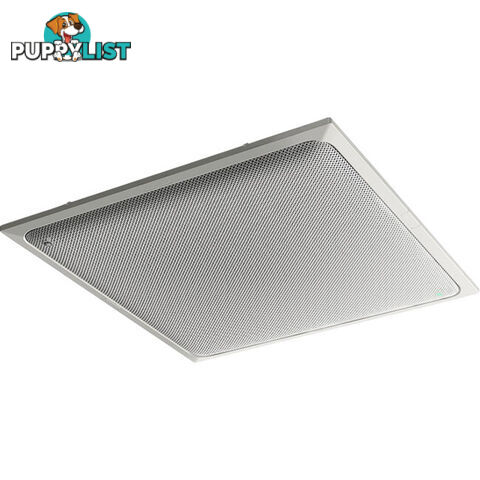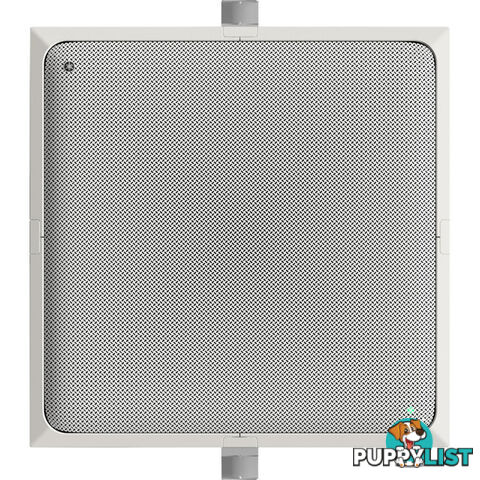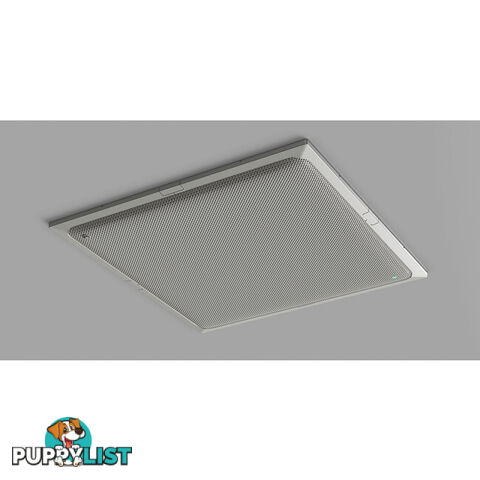RM-CGW ADECIA CEILING ARRAY MICROPHONE MULTI BEAM TRACKING
$6,820.00








DESCRIPTION
OVERVIEWYAMAHA RM-CGW WHITE CEILING ARRAY MICROPHONE
EQUIPPED WITH MULTI-BEAM TRACKING OUTSTANDING BEAMFORMING TECHNOLOGY FOR SAFELY CAPTURING EACH SPEAKERâS VOICE
RM-CG is a ceiling array microphone equipped with Multi-beam Tracking capable of tracking the simultaneous speech of multiple speakers. Since these beams detect and track the direction of the sound source simply by the speaker speaking, there is no need to adjust the position or range of sound collection in advance.
CREATING A COMFORTABLE ENVIRONMENT WITH VOICE LIFT
Voice Lift allows people in the same room to be heard clearly everywhere and a voice lift system with a ceiling array microphone, processor, power amplifier, and ceiling speakers provides a comfortable meeting and seminar environment in large conference rooms, school lecture halls, and other environments.
Learn more
CUSTOMIZE "TRACKING AREA" FOR MORE ACCURATE AUDIO PICK-UP.
Users can now pre-set RM-CG's beam-tracking zones using a color-coded system in the Web UI.
- Green represents the overall pick-up coverage of the microphone.
- Blue delineates "focus areas" for more localized sound pick up (up to 2 areas)
- Red creates an "exclusion area", cancelling audio pick-up where specified (up to 2 areas)
ACHIEVING CLEAR AUDIO QUALITY THROUGH FULL USE OF VARIOUS VOICE PROCESSING TECHNOLOGIES
As well as being equipped with all kinds of signal processing technologies such as Adaptive Echo Canceller, Noise Reduction, Dereverberation, Automatic Gain Control, and Auto Mixer, when combined with Yamaha's original HVAD (Human Voice Activity Detection) technology, this ceiling array microphone offer clear, high-quality voice reproduction.
* RM-CG HAS AUDIO SIGNAL PROCESSING TECHNOLOGY THAT SUPPORTS THE CONVERSATIONAL EXPERIENCE
OUTSTANDING BEAMFORMING TECHNOLOGY
Beamforming is a technology by which a directivity response pattern is formed using multiple microphones. The RM-CG can form up to four beams simultaneously. Narrowing the directivity of each beam and centering the beam on each speakerâs mouth enables this system to pick up sound while avoiding the negative impact of reverberation or ambient noise. Moreover, tracking with four beams offers the convenience of not having to set the sound collection range, and it prevents clipping of sound when a person begins to speak.
ADAPTIVE ECHO CANCELLER FOR MULTI-BEAM TRACKING
The Echo Canceller estimates the overall sound (including reflected sound) transmitted between speaker and microphone and reduces it (including reflected sound), thus preventing the voice from echoing back to the speaker. When the overall sound transmission is estimated perfectly, echo will not be generated. However, if the transmitted sound changes rapidly, the system will not adapt quickly enough and the likelihood of echo will increase. As mentioned above, the directions of the Multi-beam Tracking are constantly changing, but Yamaha's Echo Canceller uses an algorithm capable of responding quickly to any changes. As a result, high echo cancellation performance is achieved despite the use of Multi-beam Tracking.
NOISE REDUCTION GREATLY REDUCES AMBIENT AND BACKGROUND NOISE
Noise Reduction used in teleconferencing systems estimates the noise contained in a signal from the signal itself and attenuates its components. It enables clear sound collection by detecting steady noise and attenuating only those components.
DEREVERBERATION PROVIDES HIGH-QUALITY SOUND EVEN IN REVERBERANT SPACES
The RM-CG analyzes the components of picked-up sound in real time, then estimates and removes any unpleasant reverberation components in the sound based on an acoustic model, enhancing the clarity of the picked-up sound.
AUTOMATIC GAIN CONTROL DELIVERS CLEAR, PLEASANT CONVERSATION TO THE OTHER PARTIES
The RM-CG reduces the fluctuation in voice levels sent to other parties by automatically adjusting the gain depending on the levels of various voices picked up. In addition, HVAD (Human Voice Activity Detection) works to adjust the voice level only. In this way, HVAD prevents unpleasant sounds from being generated without unnecessarily raising the level of unwanted sound.
AUTOMATIC MIXING USING UNIQUE ALGORITHMS
General gain-sharing automatic mixing is often used when a microphone is mounted close to the speaker. When applied to the RM-CG, it tends to mix the four beams in a similar way. For this reason, the RM-CG uses automatic mixing optimized for the installation conditions, which demonstrates strong performance even in environments such as ceiling installations or rooms with a lot of reverberation.
STANDARD SUPPORT FOR DANTE NETWORK AUDIO, ENABLING DANTE AUDIO/CONTROL SIGNALS AND POE POWER SUPPLY WITH A SINGLE NETWORK CABLE
Compatible with the Dante audio network standard, enabling audio/control signals to be transmitted via a single network cable. Since the power supply is PoE-driven, not only the Dante audio signal and control signal but also the power supply can be supplied from the network switch via the same cable.
TWO UNITS CAN BE CONNECTED, SUPPORTING FLEXIBLE APPLICATIONS
In medium-sized conference rooms accommodating about 10 to 20 people, coverage can be expanded by connecting two Ceiling Array Microphones.
3 MOUNTING METHODS FOR A VARIETY OF CEILING ENVIRONMENTS
With the increasing number of conference rooms and multipurpose rooms that emphasize design as well as function, ceiling array microphones need to adapt to all kinds of installation environments. Choose your installation method, including ceiling mounting using the RM-CGâs standard metal fittings as well as installation using VESA mounting metal fittings for ceiling suspension or hanging with wires.
AUTOMATIC SOUND DETECTION AND CONFIGURATION WITH REMOTE CONFERENCE PROCESSOR RM-CR
With the ADECIA ceiling solution using the RM-CR Remote Conference Processor, voice line settings and detailed adjustments are performed automatically, which easily resolves several difficult problems associated with troublesome wiring, establishing network environments, and optimizing acoustics for each room environment.
It is also possible to adjust the RM-CGâs internal signal processing depending on the room environment and conferencing system.
SMART LOOKS AND FLEXIBLE DESIGN FOR CUSTOM CONTROL PANELS
No specialized programming skills are required. An intuitive interface makes it easy to create faders for volume control and mute on/off of RM-CR. And position photographs or other graphic elements on the tablet screen as required to create original control panels that are ideally suited to conference audio controls. In addition, ProVisionaire Touch and ProVisionaire Control can control the MRX series processor and other Yamaha Pro Audio equipment. It is easy to combine those parameters onto the one screen. ProVisionaire Control and MRX7-D can control 3rd party networked equipment using commands of Ethernet protocols, UDP, or/and TCP.
Â
SPECIFICATIONS
RM-CG General Dimensions W560 mm à D560 mm à H90 mm (Includes protrusion/microphone panel: 22 mm) Weight 5.6 kg Power Requirements PoE (IEEE 802.3af) Maximum Power Consumption 7.2 W Connector RJ45 In Operation Temperature 0°C - 40°C Humidity 30% - 90% (no condensation) Storage Temperature -20°C - 60°C Humidity 20% - 90% (no condensation) Indicator Front Indicator (Mute/Unmute & Status), Network Port Indicator Mount Ceiling mount, Wire mount, VESA mount Maximum Device Number with RM-CR 14 (without VXL1-16P, up to 16) Accessories Construction description, (Guarantee), Grille x 1, Screws for grille (M3 x 8 mm) x 5*, Screw cover x 4, Cutting template x 1, C ring x 1, Screws for C ring x 2, Hanger angle x 1, Screws for hanger angle (M4 x 20 mm) x 5*, Terminal Cover x 1, Safety wire x 1, Binding band x 1, Clamp plate x 2 *Including a spare respectively Dust Protection IP5X for dust protection (with terminal cover) Plenum Rating UL2043 (with terminal cover) Network Specifications Ether1 Dante, Remote Control, WebUI, PoE Cable Requirements Cat 5e or higher (STP) Audio Specifications Audio I/O Dante 1in/2out, In1=AEC reference signal / Out1=output of beam mix, Out2=output of beam mix (simple processed) Sampling Rate 48 kHz Bit Depth 24 bit Latency 58 ms (including signal processing), 22 ms (low-latency mode) Frequency Response 160 Hz â 16 kHz (-10 dB) Maximum Input Level of SPL (0dBFS) 117.8 dB SPL Self Noise -0.8 dBA SPL SN Ratio (Ref. 94 dB SPL at 1 kHz) 94.8 dBA Sensitivity -23.8 dBFS/Pa Dynamic Range 118.6 dBA Signal Processing Multi Beam Tracking, Adaptive Echo Canceler, Noise Reduction, Dereverberation, Auto Mixer, Auto Gain Control, Parametric EQ, Output Gain Adjustment External View Frequency Response Polar Pattern Â
ADDITIONAL INFORMATION
- Price
- $6,820.00
- Condition
- New
- Delivers To
- Australia Wide



